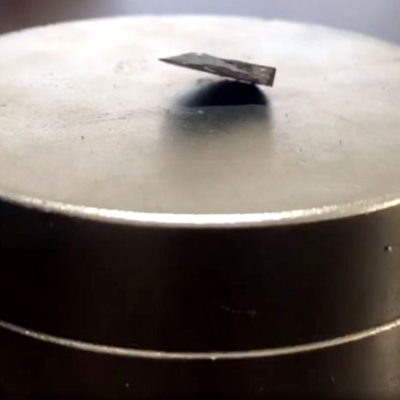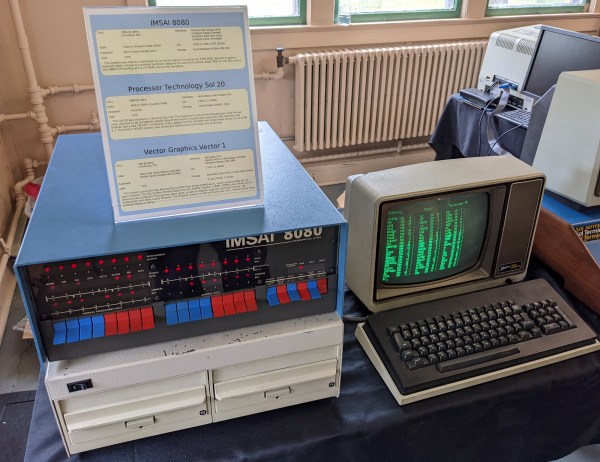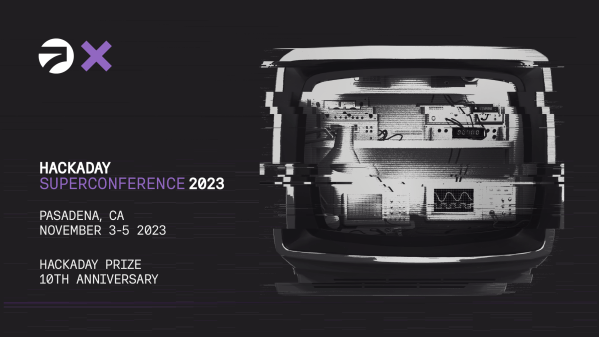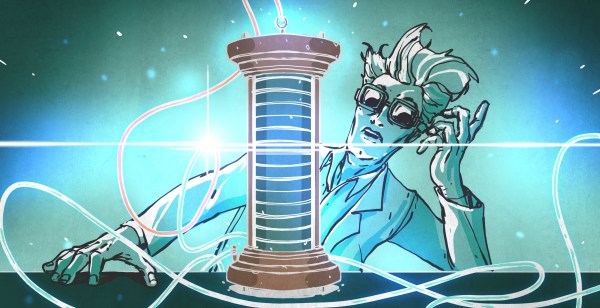Up first is a clever attack against VPNs, using some clever DNS and routing tricks. The technique is known as TunnelCrack (PDF), and every VPN tested was vulnerable to one of the two attacks, on at least one supported platform.
Continue reading “This Week In Security: TunnelCrack, Mutant, And Not Discord”
Slider4830 Articles
Ask Hackaday: Why Retrocomputing?
I recently dropped in on one of the Vintage Computer Festival events, and it made me think about why people — including myself — are fascinated with old computer technology. In my case, I lived through a lot of it, and many of the people milling around at VCF did too, so it could just be nostalgia. But there were also young people there.
Out of curiosity, I asked people about the appeal of the old computers on display there. Overwhelmingly, the answer was: you can understand the whole system readily. Imagine how long it would take you to learn all the hardware and software details of your current desktop computer CPU. Then add your GPU, the mass storage controllers, and your network interface. I don’t mean knowing the part numbers, specs, and other trivialities. I mean being able to program, repair, and even enhance it.
Keebin’ With Kristina: The One With The QWERTY Drum Set
 What does portability in a keyboard mean to you? For Hackaday’s own [Brian McEvoy], the image evokes that quintessential 80s instrument, the keytar.
What does portability in a keyboard mean to you? For Hackaday’s own [Brian McEvoy], the image evokes that quintessential 80s instrument, the keytar.
But those left-hand keys aren’t just for show — they’re macro keys. It runs on an Adafruit Feather 32u4 Bluefruit, so [Brian] can forego the cord and rock out all over the room.
I love the construction of this keyboard, which you can plainly see from the side. It’s made up of extruded aluminum bars and 2 mm plywood, which is stacked up in layers and separated with little wooden donuts acting as spacers. Unfortunately, [Brian] accidentally made wiring much harder by putting the key switches and the microcontroller on different planes.
Although you could theoretically use any key switches for this build, [Brian] chose my personal and polarizing favorite, browns. If you’re going to use a travel keyboard, you’re probably going to be around people, so blues are probably not the best choice. With browns, you kind of have yourself a middle ground, best-of-both-worlds thing going on. The keycaps are among the best parts of this build, and it seems [Brian] chose them because the legends are on the sides, which makes it much easier to type on while wearing it. Kismet!
Continue reading “Keebin’ With Kristina: The One With The QWERTY Drum Set”
Screwdrivers And Nuclear Safety: The Demon Core
Harry Daghlian and Louis Slotin were two of many people who worked on the Manhattan Project. They might not be household names, but we believe they are the poster children for safety procedures. And not in a good way.

Slotin assembled the core of the “Gadget” — the plutonium test device at the Trinity test in 1945. He was no stranger to working in a lab with nuclear materials. It stands to reason that if you are making something as dangerous as a nuclear bomb, it is probably hazardous work. But you probably get used to it, like some of us get used to working around high voltage or deadly chemicals.
Making nuclear material is hard and even more so back then. But the Project had made a third plutonium core — one was detonated at Trinity, the other over Nagasaki, and the final core was meant to go into a proposed second bomb that was not produced.
The cores were two hemispheres of plutonium and gallium. The gallium allowed the material to be hot-pressed into spherical shapes. Unlike the first two cores, however, the third one — one that would later earn the nickname “the demon core” — had a ring around the flat surfaces to contain nuclear flux during implosion. The spheres are not terribly dangerous unless they become supercritical, which would lead to a prompt critical event. Then, they would release large amounts of neutrons. The bombs, for example, would force the two halves together violently. You could also add more nuclear material or reflect neutrons back into the material.
Continue reading “Screwdrivers And Nuclear Safety: The Demon Core”
2023 Hackaday Supercon Tickets On Sale Now!
The 2023 Hackaday Superconference isn’t taking place until November, but the time to get your tickets is right now.
Hackaday’s Supercon is far and away the coolest hardware-focused hacker con of the year, and if you’re Hackaday, you absolutely want to be there. Honestly, just the crowd that Supercon brings together is reason enough to attend, but then you throw in the talks, the badge-hacking, the food, and the miscellaneous shenanigans … it’s an event you really don’t want to miss.
We’ll be announcing the speaker and workshop lineups in the upcoming weeks, but as always, we’re opening up a number of True Believer tickets for those of you who know you’ll be coming no matter what. Head on over to Eventbrite now and secure yours before they’re all gone. These usually sell out within the first few hours of being announced, so if you’re reading this right now, don’t hesitate.
Supercon is a small and friendly event, and it will be a long weekend that you’ll be looking back on fondly for the rest of the year. Whether you’ve been every time or whether you have always wanted to see what the hype is about, we can’t wait to see you all there. Come join us!
Hackaday Links: August 13, 2023
Remember that time when the entire physics community dropped what it was doing to replicate the extraordinary claim that a room-temperature semiconductor had been discovered? We sure do, and if it seems like it was just yesterday, it’s probably because it pretty much was. The news of LK-99, a copper-modified lead apatite compound, hit at the end of July; now, barely three weeks later, comes news that not only is LK-99 not a superconductor, but that its resistivity at room temperature is about a billion times higher than copper. For anyone who rode the “cold fusion” hype train back in the late 1980s, LK-99 had a bit of code smell on it from the start. We figured we’d sit back and let science do what science does, and sure enough, the extraordinary claim seems not to be able to muster the kind of extraordinary evidence it needs to support it — with the significant caveat that a lot of the debunking papers –and indeed the original paper on LK-99 — seem still to be just preprints, and have not been peer-reviewed yet.
So what does all this mean? Sadly, probably not much. Despite the overwrought popular media coverage, a true room-temperature and pressure superconductor was probably not going to save the world, at least not right away. The indispensable Asianometry channel on YouTube did a great video on this. As always, his focus is on the semiconductor industry, so his analysis has to be viewed through that lens. He argues that room-temperature superconductors wouldn’t make much difference in semiconductors because the place where they’d most likely be employed, the interconnects on chips, will still have inductance and capacitance even if their resistance is zero. That doesn’t mean room-temperature superconductors wouldn’t be a great thing to have, of course; seems like they’d be revolutionary for power transmission if nothing else. But not so much for semiconductors, and certainly not today.
Blinded With Science
So the room-temperature superconductor was a super disappointment, but even though the claims didn’t stand up in the end, the even better news is that real science was done. A paper making extraordinary claims came out, the procedure to make LK-99 was followed in multiple labs around the world, and then it was tested. It didn’t turn out to conduct particularly well at all. After a couple weeks of global superconductor frenzy, everything is back to normal again.
 What the heck happened? First of all, the paper itself made extravagant claims about a holy-grail kind of material. There was a very tantalizing image of a black pellet floating in mid air, which certainly seems like magic, even though it’s probably only run-of-the-mill ferromagnetism in the end. But it made for a great photo-op in a news-starved August, and the then-still-Twitterverse took to it by storm. And then the news outlets piled on the hype fest.
What the heck happened? First of all, the paper itself made extravagant claims about a holy-grail kind of material. There was a very tantalizing image of a black pellet floating in mid air, which certainly seems like magic, even though it’s probably only run-of-the-mill ferromagnetism in the end. But it made for a great photo-op in a news-starved August, and the then-still-Twitterverse took to it by storm. And then the news outlets piled on the hype fest.
If you’re feeling duped by the whole turn of events, you’re not alone. But the warning signs were there from the beginning, if you took the time to look. For me, it was the closing line of the paper: “We believe that our new development will be a brand-new historical event that opens a new era for humankind.”
That’s not the kind of healthy skepticism and cautious conclusion that real science runs best on. Reading the paper, I had almost no understanding of the underlying materials science, but I knew enough about human nature to suspect that the authors had rushed the paper out the door without sufficient scrutiny.
How can we keep from being fooled again? Carl Sagan’s maxim that “extraordinary claims require extraordinary evidence” is a good start. To that, I would add that science moves slowly, and that extraordinary evidence can only accumulate over time. So when you see hype science, simply wait to draw any conclusions. If it is the dawn of a new era, you’ll have a lot of time to figure out what room-temperature superconductivity means to you in the rosy future. And if it’s just a flash in the pan, you won’t have gotten your hopes up.

















